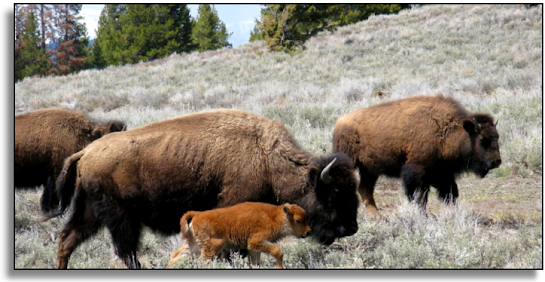Domestication is a major threat to wildness of plains bison. To retain wild genetics, a bison herd must be influenced by a preponderance of natural selection. However, herds are also subjected to genetic drift and artificial selection that replace or weaken natural selection, fostering domestication – a simplification and disorganization of the wild genome.
Genetic drift, the random transfer of genes across generations, is significant in herds <1,000 bison. Artificial selection includes interventions such as selective culling, vaccinations, and emergency feeding, and less recognized indirect effects from maintaining an unnatural herd sex-age composition, and a stable herd size at a relatively low ecological density on a small, uniform range.
In the USA, there are about 300,000 plains bison in private, public and Tribal herds, inciting beliefs that a future for wild bison is secure. But most herds are small with significant genetic drift; and are subject to many forms of artificial selection.
With over 250,000 bison, private commercial herds of livestock bison will contribute little to retaining the wild bison genome. Native American herds (about 20,000 animals) are touted as saving wild bison; but most are managed much like livestock. Tribes have important nutritional and economic needs for their bison. Intra-tribal support for wildness of bison has been uncommon or unclear, and inconsistent. Recently, the largest Tribal herd was cut from 2,000 to 200 bison.
About 30 “conservation herds” of bison owned by the Nature Conservancy or state or local governments are mostly small and subject to much artificial selection. Among these, only the American Prairie herd in Montana has goals for several thousand bison exposed to much natural selection. But these are legally private livestock and plans for American Prairie bison have been delayed and jeopardized by political opposition based in the livestock industry.
Consequently, only 15 plains bison herds in National Parks and Wildlife Refuges are managed under reliable, legal mandates to preserve wildness. The Park Service and federal refuges are mandated to retain the genetic integrity and natural ecological relations of wild bison. However, most these herds have only 300-500 bison. Only 2 herds have at least 1000 bison. These 15 herds will not suffice, in the long term, to provide a diversity of natural selection and retain the full suite of wild characteristics imbedded in bison genomes.
This emphasizes the need to restore public, wild bison on the Charles M. Russell Wildlife Refuge. It is the largest federal refuge within the historic range of plains bison. Unsuccessful efforts to reintroduce bison in this area go back to 1910. Bold federal action is needed to develop a truly wild bison herd in this, the best available location for reestablishing wild plains bison in the USA.

No comments:
Post a Comment